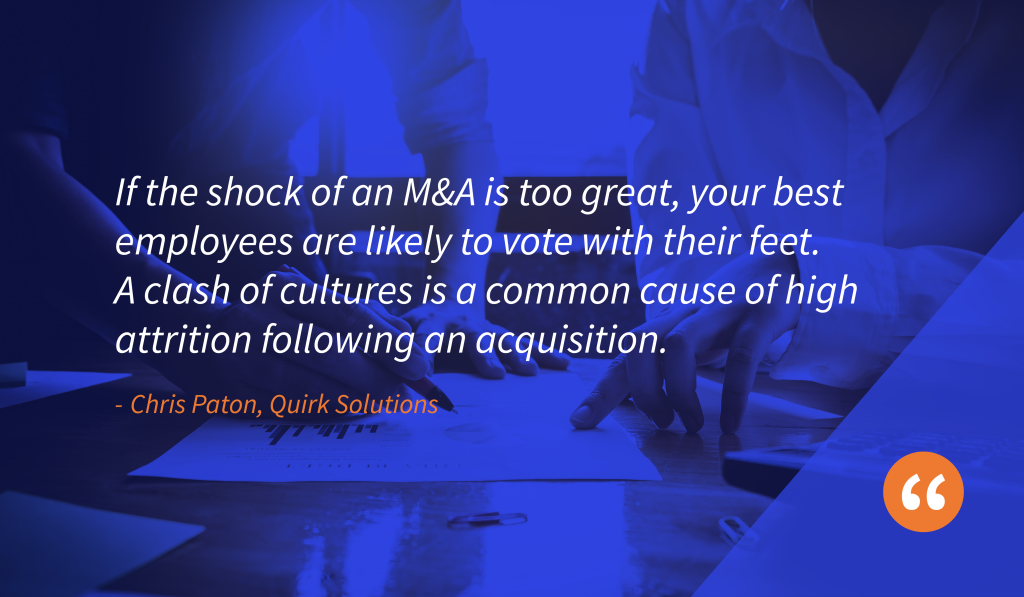A staggering two-thirds of mergers and acquisitions (M&A) fail due to cultural reasons.
The impact on the organisations involved is always significant – as M&A failure leads to substantial monetary losses and wasted time, effort and resources investment. The mental and emotional investments count too.
Yet leaders often don’t give the cultural aspects of M&A the attention it deserves. Understanding culture and proactively managing it means the process is much more likely to succeed.
This article discusses why leaders need to consider culture during M&A and how Quirk Solution’s cultural diagnosis can help organisations come together quickly with successful outcomes.

A clash of two cultures
There are many reasons to conduct a merger or an acquisition, but just as no two people are the same, no two organisations are a perfect culture match. Understanding and addressing the differences is vital to achieving the deal’s goals.
The story of Amazon’s 2017 acquisition of Whole Foods comes to mind. The deal’s goal was to allow Amazon to grow beyond e-commerce and sell groceries in hundreds of stores, collecting large amounts of shopper data. For Whole Foods, the deal would drive lower prices and economies of scale after a recent decline in the market.
But after a year, the deal still needed to provide the anticipated outcomes. There were stories of employees crying over changes that Amazon made. Some Whole Foods employees had taken steps to unionise, and customers had become angry over understocked stores.
The benefits of Amazon and Whole foods coming together had great promise – leveraging each other’s strengths had the potential to amplify the organisation’s value. But the leaders failed to investigate their cultural fit beforehand.
The same principles apply at any scale but are particularly crucial in the mid-market. These are organisations growing fast by acquiring many smaller businesses per year. Cultural mismatches slow the integration, delaying expected returns and can cause doubt in investors’ minds. The pace of acquisitions often compounds the problem – many mid-market organisations are scaling so fast that they can simultaneously find themselves with two or even three culture acquisition problems.
Acknowledge the shock of M&A
Culture affects all business areas, from behaviours to stakeholder relations. Russell Clements, who grew SThree from a start-up to a PLC, says, “Culture is your only differentiator – because it determines how employees treat each other, how they engage with clients and suppliers, how the business performs”.
When an organisation is acquired, it significantly impacts its people and teams. They can be suspicious, fearful, anxious, or excited. Rumours will abound, and any disparities will be seized. For instance, differences in standard policies, such as maternity leave, can unsettle the workplace. If you are heavily pregnant and you hear of changes to your maternity leave rights, that will cause anxiety.
Pretty much all acquisitions will follow the Kübler-Ross change curve. The change curve, created by Elisabeth Kübler-Ross in 1969, depicts five stages:
1. Shock & denial
2. Anger
3. Bargaining
4. Depression
5. Acceptance
Leaders need to be very aware of the shock/change that newly acquired employees will go through and the effect on how the organisation operates. Handled poorly, employees may quit over changes that do not suit them – which is a disaster, as the loss of that talent will almost certainly cause a failure to realise the objectives of the acquisition.
The smaller the shock, the more quickly an organisation can deliver and perform at its best. The greater the shock, the longer it takes to succeed if the organisation delivers on its goals at all.
Ignore culture at your peril
Cultural differences are not a bad thing. Indeed, they can (handled correctly) be a considerable strength, bringing a diversity of thinking and new ways of working.
The real reason for M&A failures is the lack of or inability to identify the differences, acknowledge them and bridge the gap. Which norms should remain, and what should be addressed as a matter of urgency?
Businesses that don’t consider culture run the risk of making the venture fail in the long term.

Typically, organisations experience the impact of poor cultural fit in three areas – lag time, retention, and financial performance.
Lag time: Employees take longer to settle
All M&A processes generate a ‘lag time’ – the point between the two organisations signing the agreement and full integration/performance. Reducing the lag time can have exponential advantages in margin and expected returns. When leaders ignore culture, it may take longer for a business to settle into a merged organisation. Without an understanding of culture, e.g. behaviours and mindset, the changes will take employees longer to process. But when organisations work on culture, employees benefit from clear communication. They understand what is happening and why. Focusing on culture in the early stages of an M&A allows employees to feel supported and go through the change curve faster.
Retention: Organisations lose their best people
In the Amazon-Whole Foods deal, Amazon had a tighter culture – a larger business with more structure. Whole Foods was a smaller, entrepreneurial company operating with a looser culture. Employees that prefer consistency and routine might struggle with Whole Foods’ culture, for instance. Paying attention to cultural differences at the outset of an M&A helps identify these misalignments. Leaders can then act on the recommendations, adopting a people-first approach to avoid pitfalls such as losing their best people.
Financial performance: Increased costs
Leaders expect a healthy return on their investment in an acquisition, in line with the M&A objectives. But if employees are anxious about the ongoing changes and cultural challenges, absences and sick leave will rise. Organisations will likely backfill key roles to meet resource needs. From a financial viewpoint, overhead costs might spiral without a comparative rise in turnover and profits. The Kübler-Ross change curve mentioned before is an excellent tool for helping employees in both organisations understand, early on, the different emotions they will go through. Early acceptance of change reduces the chances of unnecessary absences and sick leave.
Although this article focuses primarily on the organisations making the M&A, culture fit is also vital on the other side of the coin, i.e. when considering investment options for growing companies. Gymshark is a superb example of ensuring that the best possible culture fit was in place before accepting the deal.
Quirk’s cultural diagnosis for M&As
At Quirk, we help leaders assess cultural fit and improve acquisition integration. We provide a pre-acquisition analysis, which identifies misalignment, people issues and skills gaps across both cultures. We do this assessment in various ways, from overt engagement to discreet enquiries, depending on the sensitivity of the acquisition process.
Our approach will vary depending on the way you want to work. For example, if you need to keep knowledge of the impending M&A very limited, we have a service that maintains discretion and works alongside the business owner only. If you do want your team involved to an extent, we tailor how we deliver workshops to suit. And if you are completely open, we will work with the whole team at each step.
Post-acquisition, we use our Quirk App and focus groups to gain an even deeper understanding of the organisational cultures. Based on our findings, we design and deliver a bespoke integration package that addresses the gaps. The focus groups give a sense of what is crucial to the acquired people, their concerns, and how they like to work.
Throughout the M&A process, our approach identifies opportunities, gaps and misalignments. We can then create a set of recommendations to overcome potential challenges. If the acquisition goes ahead, you’ve got an implementation plan that you can execute straight away, reducing lag time.
If you’d like further information about Culture in M&A, email us at [email protected]. We would be delighted to hear from you.



